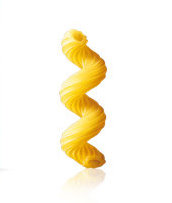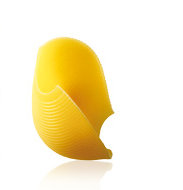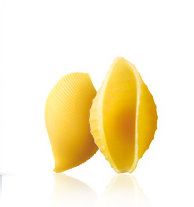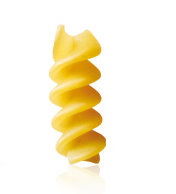Pasta comes in many appealing shapes and sizes. Below is a list of the most common shapes of pasta, and a general overview of how each can be used. This is by no means a complete list. Shown below are the pasta shapes that are readily available and that are suited for use in macaroni and cheese recipes, macaroni casseroles and macaroni salads.
Long, short, thick, thin – the varieties of pasta are nearly endless. Each can easily become a new favorite of any pasta lover.
Campanelle
Campanelle is a delicate but sturdy shape, which means “Bellflowers” in Italian. Campanelle has fluted, petal-like edges and a hollow center for capturing sauce. Campanelle adds a touch of elegance and charm to your dining table. This shape is wonderful in a summer macaroni salad brimming with fresh vegetables from the garden.
Cellentani
Cellentani is corkscrew-shaped pasta. Cellentani is as fun to look at as it is to eat. With its tubular center and ridged surface, Cellentani is perfect for a hearty pasta meal. It captures every drop of your favorite sauce and traps vegetables, meat or fish in every delicious forkfull. Cellentani is also excellent for cold pasta salads and casseroles. Its corkscrew shape makes it strong enough to partner with thick sauces while it’s rich pasta flavor comes through in every bite.
Elbows
Elbows are known as Gomiti or Chifferi in Italian. Elbows are named for their twisted tubular shape that can vary in size to nearly ½” across. This pasta can be either smooth or ridged. The grooved or ridged pasta are called rigati Pasta elbows originated from Northern and Central Italy where they are traditionally used in any number of traditional Italian meals. These dishes include soups, baked pasta dishes, or tossed with vegetable or cheese sauces.
Farfalle
Farfalle dates back to Italy in the 1500s. This pasta shape originated in Lombardia and Emilia-Romagna in Northern Italy. Farfalle, which means “butterfly” in Italian, are rectangular or oval pieces of pasta that are pinched in the middle. They come in various sizes such as Farfalline which means tiny butterflies in Italian, Farfallette which means little butterflies in Italian and Farfalloni which means big butterflies in Italian. In the United States they are often referred to as bow pasta. They are versatile and can be used in many dishes. Served hot, they are good with light delicate sauces and vegetables. Served cold, they are an excellent shape to be used for macaroni and other pasta salads.
Fiori
Fiori, a petal shaped pasta, is named from the word Italian word Fiorire, meaning to blossom or to flower. Fiori’s unique shape, with six petal shapes surrounding the center, adds both visual interest as well as a distinctive mouth feel when you bite down. Try Fiori in cold macaroni pasta salad, tossed with a creamy cheese sauce or bathed it in a classic tomato-fresh basil sauce.
Gemelli
Gemelli is a simple pasta shape with two strands of pasta twisted together. Gemelli means “twins” in Italian. They are also known in the United States as twists Napoletani. Gemelli pairs with any number of delicious Italian sauces, from rich tomato, mozzarella and basil in Naples to traditional pesto and green beans in Genoa. These small pasta twists are also remarkably versatile, as their shape holds the flavor of sauce beautifully while retaining the firm “al dente” texture that quality pasta has.
Jumbo Shells
This shape in Italy is called either Conchiglie or Maruzze. Stuffed shells are traditionally found in the South of Italy, where stuffed pasta dishes are frequently prepared. Jumbo Shells are a large, graceful, concave shape inspired by the shape of sea shells. This enchanting shape envelops whatever flavorful stuffing is used to fill the shells. A harmony of colors and tastes are brought to life by this innovative stuffed shell. Jumbo Shells provide the molding for a perfect baked pasta dish.
Large Shells
Large shells are a smaller version of Jumbo Shells. These shells have a shape that resembles a shellfish, Large Shells are inspired by the sea-side towns of Naples and Genoa. The graceful, concave shape is covered in ridges to capture the flavor of the sauce. Large Shells offer the same delicious taste and versatility as the other shell shapes. You may pair Large Shells with either hearty tomato or meat-based sauces.
Manicotti
Manicotti is one of the oldest shapes of pasta that is still prepared today in much the same way as it was originally made. In ancient times, pasta dough was prepared, cut into large rectangles, filled with flavorful stuffing, then rolled and baked in the oven. Manicottis are large hollow pasta tubes, approximately 3-4 inches long and 1 inch in diameter. This elegant shaped pasta is typically stuffed with a rich cheese mixture and baked in flavorful sauces. Manicottis are versatile and ideal for rich, distinctive sauces. Manicotti is especially well suited for entertaining.
Medium Shells
Medium Shells also have a shape that resembles a seashell. It is easy to see where the locals in the sea-side communities of Naples and Genoa got their inspiration for the creation of Medium Shells. In Italy they are called Mezzo Conchiglie. The shells graceful, concave shape is covered in ridges. Both the ridges and generous cup created from the hollowed curve allow this pasta to capture the flavor of whatever sauce is added to the pasta. The shells ridges retain sauces beautifully, while their subtly nutty flavor enhances everything from a refined tomato-cream sauce to a traditional chunky meat ragu.
Mezze Penne
As with the larger version Penne, Mezze Penne resembles an old-style quill pen. This shape is enjoyed throughout Northern Italy and in Campagnia where it is prized for its wonderful versatility and its ability to absorb and retain sauce on its surfaces, inside and out. Mezze Penne is very slender and slightly shorter than Penne; yet maintains the ridges that help to hold the sauce, resulting in a tantalizing taste experience. Whether bathed in a rich tomato sauce, or paired with a traditional spicy arrabiata, Mezze Penne is the perfect pasta.
Mezze Rigatoni
Mezze Rigatoni is a shorter version of Rigatoni. It is a surprisingly versatile pasta shape. Combining the heartiness of traditional Rigatoni, a shape that is most commonly used in Southern and Central Italy, with a smaller size makes for a delightful variation on an old favorite that is sure to delight your family and friends. Mezze Rigatoni works well with any sauce base, either cream or tomato.
Mostaccioli
Mostaccioli, known in Italy as “Penne Lisce,” or small moustaches is a specialty of the Campania Region in southern Italy which includes the cities of Naples, Capri and Sorrento. Penne are tube-shaped, about 2” long, with angled ends cut to resemble a quill or pen point. Unlike penne which are ridged, mostaccioli is smooth in texture. Mostaccioli’s smooth surface brings out the best in any kind of sauce, particularly light and fresh ones. They are best used with smooth tomato, or cream sauces. They are also commonly used in baked dishes with tomato sauce and cheese.
Penne
Penne is one of the most well known Italian pasta shapes and is loved across Italy. Penne, which means “pen” in Italian, gets its name from its shape. Their tube-shape with angled ends was inspired by the quill of an old style ink pen. The smallest size of this pasta is known as Pennine. The largest is known as Pennone Penne have ridges which allow the Penne to hold more sauce. Ridged Penne are designed for meat, vegetable, cheese and oil or butter-based sauces. They are also perfect for baked dishes made with sauce and cheese. Penne all’Arrabbiata, Penne with a spicy tomato sauce, is a favorite Italian dish.
Pipette
Pipette, meaning “little pipe” in Italian, is commonly found in the pasta dishes of Campania and Liguria. However, pipe shaped pasta can be found throughout the various regions of Italy. In Naples cooks prefer larger pipe shaped pasta for baked pasta dishes. North Central Italians prefer smaller versions. Pipettes are a charming, delicious pipe-shaped pasta with curves and grooves to retain sauce inside and outside. The pipe is open at both ends with one of them pinched to capture even more bits of the sauce.
Rigatoni
Rigatoni, inspired by ‘riga’ (ridges), is one of Italy’s most beloved pasta shapes. From the region of Italy near Rome, this classic pasta shape is found in countless recipes. Rigatoni, a wide, ridged, tube-shaped pasta, has holes that are large enough to capture pieces of meat or vegetables in sauces. They have ridges which allow them to hold more sauce. Rigatoni is ideal for meat or vegetable sauces and is also perfect for baked dishes made with sauce and cheese.
Rotini
Rotini means “twists” and are 2” lengths of thick screw-like pasta from Northern Italy. The shape was inspired by children since it is fun-to-eat and pairs well with a wide variety of sauces. The twists allow Rotini to hold more sauce and they may be enjoyed with your favorite pasta salad dishes or paired with tasty tomato-based sauces.
Tri-Color Fiori
A colorful version of a pasta salad favorite, Tri-Color Fiori is a flower-shaped pasta. Its name is derived from the word Italian word Fiorire, meaning to blossom, to bloom or to flower. This elegant shape adds visual interest as well as a unique mouth feel. It is one of the most popular shapes in Italy and America because of its fun, delightful presentation, and authentic Italian flavor. The red and green colored pasta is made by adding tomato flour or spinach flour to the pasta dough. Tri-Color Fiori is excellent as the centerpiece of a pasta salad, tossed with a creamy cheese sauce, or bathed in a classic tomato sauce.
Tri-Color Rotini
A colorful version of a pasta salad favorite, Tri-Color Rotini means “colorful twists”. They are 2” lengths of thick screw-like pasta from the Northern Italian region. The shape was inspired by children since it is fun-to-eat and pairs well with a wide variety of sauces. The red and green colored pasta is made by adding tomato flour or spinach flour to the pasta dough. The twists allow Tri-Color Rotini to hold more sauce and they may be enjoyed in your favorite pasta salad dishes or paired with tasty tomato-based sauces.
Wheels
Wheels, known as Rote in Italian, are a version of the beloved wagon wheel shape and are always a ‘kid favorite’. These classic shapes originated in Italy during the 1950’s, inspired by modern industry. There is a mini version of this shape known in Italy as Rotelle or small wheels. Wheels’ exterior ridged surface, six-spokes and center-hub come together to create a fun and flavorful eating experience for the young and the young at heart.




















